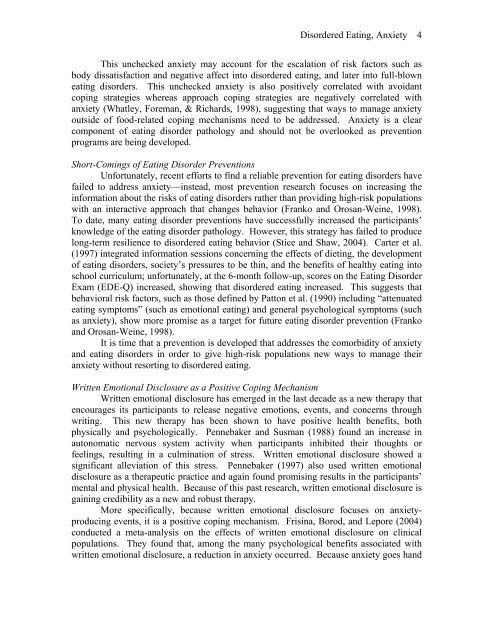The Secret Society: Descendants of Crypto-Jews in the San Antonio ...
The Secret Society: Descendants of Crypto-Jews in the San Antonio ...
The Secret Society: Descendants of Crypto-Jews in the San Antonio ...
You also want an ePaper? Increase the reach of your titles
YUMPU automatically turns print PDFs into web optimized ePapers that Google loves.
Disordered Eat<strong>in</strong>g, Anxiety 4<br />
This unchecked anxiety may account for <strong>the</strong> escalation <strong>of</strong> risk factors such as<br />
body dissatisfaction and negative affect <strong>in</strong>to disordered eat<strong>in</strong>g, and later <strong>in</strong>to full-blown<br />
eat<strong>in</strong>g disorders. This unchecked anxiety is also positively correlated with avoidant<br />
cop<strong>in</strong>g strategies whereas approach cop<strong>in</strong>g strategies are negatively correlated with<br />
anxiety (Whatley, Foreman, & Richards, 1998), suggest<strong>in</strong>g that ways to manage anxiety<br />
outside <strong>of</strong> food-related cop<strong>in</strong>g mechanisms need to be addressed. Anxiety is a clear<br />
component <strong>of</strong> eat<strong>in</strong>g disorder pathology and should not be overlooked as prevention<br />
programs are be<strong>in</strong>g developed.<br />
Short-Com<strong>in</strong>gs <strong>of</strong> Eat<strong>in</strong>g Disorder Preventions<br />
Unfortunately, recent efforts to f<strong>in</strong>d a reliable prevention for eat<strong>in</strong>g disorders have<br />
failed to address anxiety—<strong>in</strong>stead, most prevention research focuses on <strong>in</strong>creas<strong>in</strong>g <strong>the</strong><br />
<strong>in</strong>formation about <strong>the</strong> risks <strong>of</strong> eat<strong>in</strong>g disorders ra<strong>the</strong>r than provid<strong>in</strong>g high-risk populations<br />
with an <strong>in</strong>teractive approach that changes behavior (Franko and Orosan-We<strong>in</strong>e, 1998).<br />
To date, many eat<strong>in</strong>g disorder preventions have successfully <strong>in</strong>creased <strong>the</strong> participants’<br />
knowledge <strong>of</strong> <strong>the</strong> eat<strong>in</strong>g disorder pathology. However, this strategy has failed to produce<br />
long-term resilience to disordered eat<strong>in</strong>g behavior (Stice and Shaw, 2004). Carter et al.<br />
(1997) <strong>in</strong>tegrated <strong>in</strong>formation sessions concern<strong>in</strong>g <strong>the</strong> effects <strong>of</strong> diet<strong>in</strong>g, <strong>the</strong> development<br />
<strong>of</strong> eat<strong>in</strong>g disorders, society’s pressures to be th<strong>in</strong>, and <strong>the</strong> benefits <strong>of</strong> healthy eat<strong>in</strong>g <strong>in</strong>to<br />
school curriculum; unfortunately, at <strong>the</strong> 6-month follow-up, scores on <strong>the</strong> Eat<strong>in</strong>g Disorder<br />
Exam (EDE-Q) <strong>in</strong>creased, show<strong>in</strong>g that disordered eat<strong>in</strong>g <strong>in</strong>creased. This suggests that<br />
behavioral risk factors, such as those def<strong>in</strong>ed by Patton et al. (1990) <strong>in</strong>clud<strong>in</strong>g “attenuated<br />
eat<strong>in</strong>g symptoms” (such as emotional eat<strong>in</strong>g) and general psychological symptoms (such<br />
as anxiety), show more promise as a target for future eat<strong>in</strong>g disorder prevention (Franko<br />
and Orosan-We<strong>in</strong>e, 1998).<br />
It is time that a prevention is developed that addresses <strong>the</strong> comorbidity <strong>of</strong> anxiety<br />
and eat<strong>in</strong>g disorders <strong>in</strong> order to give high-risk populations new ways to manage <strong>the</strong>ir<br />
anxiety without resort<strong>in</strong>g to disordered eat<strong>in</strong>g.<br />
Written Emotional Disclosure as a Positive Cop<strong>in</strong>g Mechanism<br />
Written emotional disclosure has emerged <strong>in</strong> <strong>the</strong> last decade as a new <strong>the</strong>rapy that<br />
encourages its participants to release negative emotions, events, and concerns through<br />
writ<strong>in</strong>g. This new <strong>the</strong>rapy has been shown to have positive health benefits, both<br />
physically and psychologically. Pennebaker and Susman (1988) found an <strong>in</strong>crease <strong>in</strong><br />
autonomatic nervous system activity when participants <strong>in</strong>hibited <strong>the</strong>ir thoughts or<br />
feel<strong>in</strong>gs, result<strong>in</strong>g <strong>in</strong> a culm<strong>in</strong>ation <strong>of</strong> stress. Written emotional disclosure showed a<br />
significant alleviation <strong>of</strong> this stress. Pennebaker (1997) also used written emotional<br />
disclosure as a <strong>the</strong>rapeutic practice and aga<strong>in</strong> found promis<strong>in</strong>g results <strong>in</strong> <strong>the</strong> participants’<br />
mental and physical health. Because <strong>of</strong> this past research, written emotional disclosure is<br />
ga<strong>in</strong><strong>in</strong>g credibility as a new and robust <strong>the</strong>rapy.<br />
More specifically, because written emotional disclosure focuses on anxietyproduc<strong>in</strong>g<br />
events, it is a positive cop<strong>in</strong>g mechanism. Fris<strong>in</strong>a, Borod, and Lepore (2004)<br />
conducted a meta-analysis on <strong>the</strong> effects <strong>of</strong> written emotional disclosure on cl<strong>in</strong>ical<br />
populations. <strong>The</strong>y found that, among <strong>the</strong> many psychological benefits associated with<br />
written emotional disclosure, a reduction <strong>in</strong> anxiety occurred. Because anxiety goes hand
















